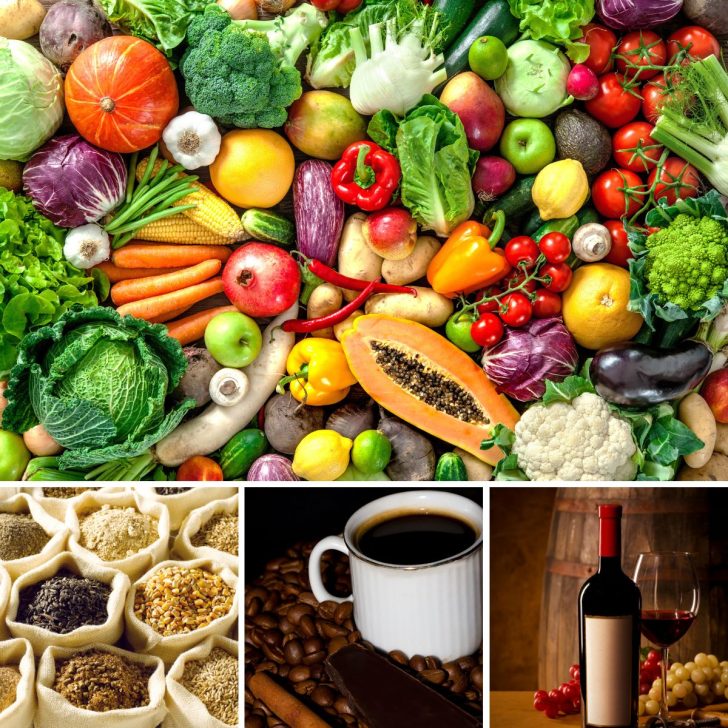Gardeners who grow their own food have access to some of the healthiest and most delicious foods possible. You’ve probably heard of polyphenols and flavonoids as something healthy, but what are they, and what foods contain them?
Probably like you, we’ve heard about polyphenols and flavonoids for years. More recently while working on a series of articles on microgreens, these compounds kept coming up, so finally, we paused long enough to do a quick dip into the research to discover what are polyphenol and flavonoids?
Polyphenols and Flavonoids From Plants
Polyphenols and Flavonoids are chemical compounds found in plants. Surprise!…these nutrients are known for their health benefits! 🤓 If you’re growing your own food (and/or eating lots of fruits and veggies), then you’re enjoying the benefits of lots of these amazing natural nutrients.
Here’s a brief overview of each of these:
Polyphenols
- Definition: Polyphenols are a category of chemicals naturally found in many plant foods. They are characterized by the presence of more than one phenol unit or building block per molecule.
- Sources: They are abundant in fruits, vegetables, tea, coffee, red wine, dark chocolate, and some whole grains.
- Types: There are several types of polyphenols, including flavonoids, phenolic acids, polyphenolic amides, and other polyphenols. Each type has different properties and potential health benefits.
- Health Benefits: Polyphenols are known for their antioxidant properties, which can help in fighting oxidative stress and may reduce the risk of several chronic diseases. They are also associated with reduced inflammation and may have a role in heart health, diabetes prevention, and cancer risk reduction.[1]https://pubmed.ncbi.nlm.nih.gov/21432698/
Flavonoids
- Definition: Flavonoids are a type of polyphenol and are among the most widespread and diverse group. They are characterized by a particular structure consisting of two phenol rings connected by a three-carbon bridge.
- Sources: Flavonoids are found in a variety of fruits, vegetables, grains, bark, roots, stems, flowers, tea, and wine.
- Types: They are classified into several sub-groups, including flavones, flavonols, flavanones, isoflavones, catechins, and anthocyanins, each with unique properties and health benefits.
- Health Benefits: Like polyphenols, flavonoids are powerful antioxidants with anti-inflammatory properties. They have been linked to a variety of health benefits, including improved heart health, cancer prevention, and brain health. They may also play a role in preventing neurodegenerative diseases and improving immune function.
Both polyphenols and flavonoids are the subject of ongoing research to fully understand their health effects and potential therapeutic uses. Their benefits are believed to be best obtained through a diet rich in a variety of plant-based foods.
You may also enjoy our article on some of the healthiest microgreens.
References
- Effects of Flavonoids and Other Polyphenols on Inflammation[2]https://pubmed.ncbi.nlm.nih.gov/21432698/
- Health Benefits of Polyphenols[3]https://pubmed.ncbi.nlm.nih.gov/35694805/
Comparison Chart Summary of Polyphenols and Flavonoids
| Property | Polyphenols | Flavonoids |
|---|---|---|
| Definition | Diverse group of phytochemicals with more than one phenol unit per molecule. | A large subgroup of polyphenols characterized by their chemical structure. |
| Subclasses | Includes flavonoids, phenolic acids, stilbenes, lignans, etc. | Includes flavones, flavonols, flavanols, flavanones, anthocyanins, isoflavones. |
| Sources | Found in fruits, vegetables, tea, coffee, red wine, and chocolate. | Found in a variety of fruits, vegetables, grains, tea, and wine. |
| Health Benefits | Antioxidant properties, may reduce risk of chronic diseases, anti-inflammatory, improves cholesterol, blood pressure, insulin resistance. | Support heart health, may prevent certain cancers, neuroprotective effects. |
Now that you know a little more about some of the fruit and vegetable “super powers”, you may also enjoy discovering some of the best cooking oils for high heat, as well as healthiest way to cook vegetables.
I’m LeAura Alderson, a garden, herb and plant enthusiast with a passion for discovering the many edible and medicinal benefits of the plants all around us, including the weeds! I’m a writer, editor and media publisher for our family of websites.
While I was certified in fitness and life coaching, I am NOT a health practitioner. However, I’m a lifelong health enthusiast, with a keen interest in healthy, organic foods and making home remedies and the content we share is from our own experience and usage as well as that extracted from scientific research so that you can explore further on your own.
Always seek the advice and guidance of your health practitioners first and foremost.
As a family we’re steadily expanding our gardening, experimentation and knowledge around all things gardening, edible landscaping, fresh organic foods and self sustainability with farming in our future. I also own and manage iCreateDaily.com, a site all about transformation through creation, and the power of positivity, optimism and mindset.
References

